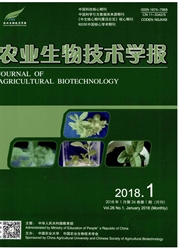

 中文摘要:
中文摘要:
CD4分子是辅助性T淋巴细胞表面的重要标志,广泛参与T细胞受体对主要组织相容性复合物Ⅱ(major histocompatibility complexⅡ,MHCⅡ)分子递呈抗原的识别和信号传递,与细胞免疫应答和防御机制紧密相关.本研究采用RT-PCR方法克隆牦牛(Bos grunniens) CD4的开放阅读框,通过实时荧光定量PCR(quantitative Real-time PCR,qRT-PCR)、Western blot及免疫组织化学链霉亲和素-生物素-过氧化物酶复合物技术(streptavidin biotin-peroxidase complex method,SABC)检测成年牦牛的主要免疫器官(胸腺、脾、肠系膜淋巴结及血结)内CD4 mRNA及蛋白的表达.RT-PCR反应扩增得到牦牛CD4 mRNA序列编码区长为1 188 bp,编码396个氨基酸,与黄牛(Bos taurus)有较高的同源性.qRT-PCR和Western blot检测结果显示,CD4 mRNA及蛋白在各淋巴器官中均有表达,且在胸腺表达量最高,肠系膜淋巴结、血结次之,脾表达量最低(P<0.01).免疫组织化学结果显示,CD4阳性细胞在胸腺皮质、髓质均有分布;在脾主要分布在动脉周围淋巴鞘和红髓髓索;在肠系膜淋巴结及血结内,则主要分布在淋巴小结周边及髓索.结果提示,牦牛胸腺是CD4阳性T淋巴细胞主要的输出器官,其输出量可能影响次级淋巴器官内T细胞含量;血结可能与淋巴结及脾一样,在细胞免疫发挥同等重要的作用.本研究为牦牛免疫遗传学和免疫生物学等相关研究奠定基础,同时也将为适时免疫、致病机理和疾病防治等研究提供新的资料.
 英文摘要:
英文摘要:
CD4 is a membrane-bound glycoprotein found on T cells, and also an important surface marker of helper T lymphocyte. This molecule widely involves in recognition of specific antigens in association with major histocompatibility complex Ⅱ (MHC Ⅱ ) molecules and transmembrane signal transduction. Expression of CD4 is critical for cell-mediated immune response and defense mechanisms. In this study, the yak (Bos grunniens) CD4 open reading frame (ORF) was cloned and sequenced using RT-PCR, and the CD4 mRNA and protein levels of adult yak thymus, spleen, mesenteric lymph nodes and haemal nodes were detected by means of qRT-PCR (quantitative Real-time PCR), Western blots and immunohistochemical streptavidin biotinperoxidase complex (SABC) method. The results showed that yak CD40RF contained 1 188 bp, encoded 396 amino acids. The cDNA sequences of yak CD4 revealed significant homology with Bos taurus. The results of qRT-PCR and Westem blots showed that CD4 mRNA and protein widely expressed in lymphoid tissues. The expression levels in the thymus was higher than that in other lymphoid tissues (P〈0.01); additionally the levels of haemal nodes was similar to that of mesenteric lymph nodes, and both of them were higher than those for spleen (P〈0.01). The immunohistochemical results showed that the CD4+ cells were distributed in the cotex and medulla of yak thymus. In the spleen, many CD4+ cells were located in the periarteriolar lymphoid sheaths and red pulp. Moreover CD4 + cells in mesenteric lymph nodes and haemal nodes were mainly presented in the mantle zone and medulla cord. The results indicated the thymus was a primary lymphoid tissue responsible for CD4+ T lymphocytes exportation and thymic production may influence the T lymphocytes extent of secondary lymphoid tissues. Then haemal nodes might have similar functions as the mesenteric lymph nodes and spleen. This study would provide fundamental data for immunogenetics and immunobiology, and also bring a new insight into time
 同期刊论文项目
同期刊论文项目
 同项目期刊论文
同项目期刊论文
 期刊信息
期刊信息
